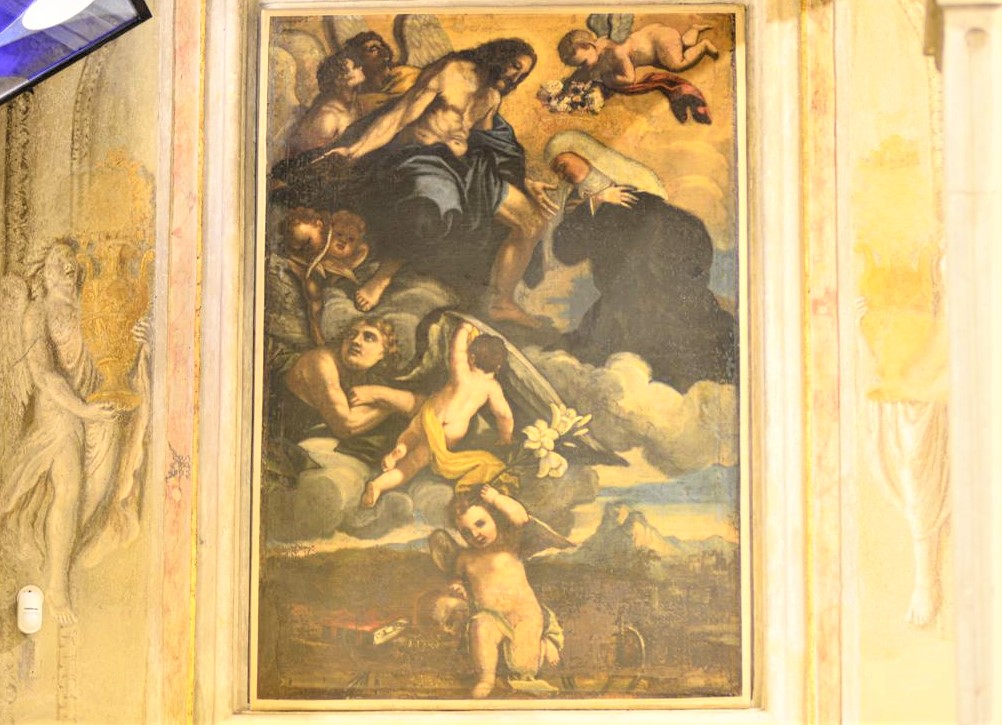When in 1974 the Pieve Collegiata church in the far west of the Tuscan hillside area of Cerbaie, was dedicated to San Giovanni Apostolo and Evangelista di Santa Maria a Monte (Pisa), it underwent major restoration, and a canvas was recovered from its attics.
[caption id="attachment_120339" align="center-block" width="1002"] Picture by Simone Massetani[/caption]
Picture by Simone Massetani[/caption]
After a quick restoration, it was placed above the new niche that housed the urn with the relics of Blessed Diana, a local saint who lived between the twelfth and thirteenth centuries.
The canvas, 300 x 200 centimetres in size, was attributed to an anonymous 17th century artist on that occasion.
From the summary examination of the work it was already possible to realize that the painting has been retouched several times. However, the pictorial elements it expresses lend themselves to a dating: 17th century.
The work depicts Blessed Diana facing the Risen Christ in a crowd of angels. In the early 1980s, the canvas itself risked being destroyed when it was lapped by a fire, fortunately causing only minor damage.
However, the work has so far had little consideration, as no one had grasped the similarity with the upper half of the large altarpiece (720 x 423 cm) painted by Guercino between 1622 and 1623, which depicts the burial of Santa Petronilla. The work is housed in the Capitoline Museums in Rome.
The comparison between the two works is surprising: not only the scene depicted is superimposable in its presentation, but there are also many details that coincide.
In the canvas of Santa Maria a Monte, albeit of a smaller size, the scene of the glorification of the saint is re-positioned, which in this case is Blessed Diana "kneeling before Christ who welcomes her into heaven".
Among the characters participating in the event, the Blessed Diana appears as a technically less important subject, as if to suggest a subsequent change to the scene.
It is also noted that the upper part of the canvas gives the impression of not being the original one, as it shows abrupt termination of some elements such as the incompleteness of the angel's wing that holds the floral crown over the head of the Blessed.
The comparison of the two works, their chronological coincidence, call for a more detailed analysis by scholars in order to define the relationship between the Burial of Santa Petronilla in the Capitoline Museums in Rome and the canvas of the Collegiate Church of Santa Maria a Monte.
The hypotheses can be various.
One aspect in particular deserves further study: the canvas could be the work of a "copyist" of Guercino. In fact, the artist founded a school in Cento (the artist's hometown), initially attended by the youthful collaborators of the young Guercino, and a group of his "official" engravers and copyists were formed.
Among them we can mention Pietro Desani, Pietro Armani, Paolo Antonio Barbieri, Giuseppe Maria Galoppini, Bartolomeo, Cesare, Ercole and Lorenzo Gennai, Matteo Loves, Francesco Riva, Cesare Scala, Benedetto Zalone, all active precisely in the seventeenth century, especially in northern and central Italy.
We therefore want to hope that what has been reported will arouse the interest of scholars, in order to deepen the aspects that we have summarized.
In these cases, everything can fit. And I really mean ... "everything".
Cover picture by Simone Massetani







Follow us